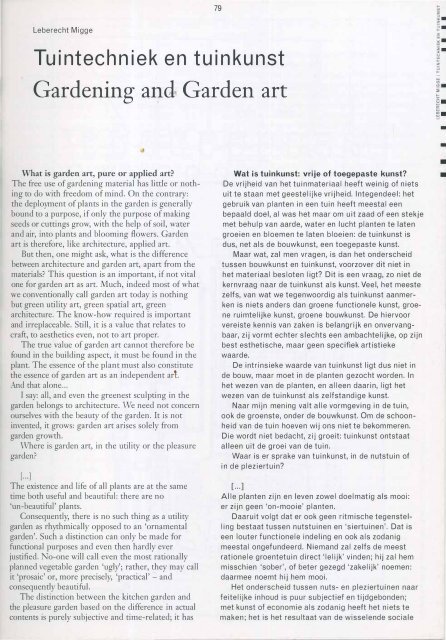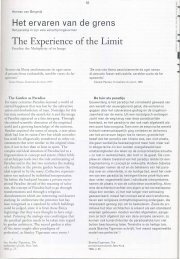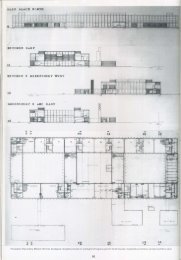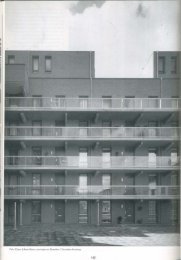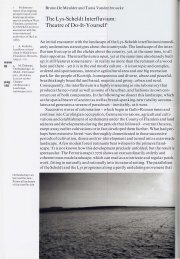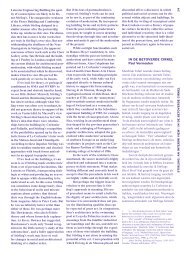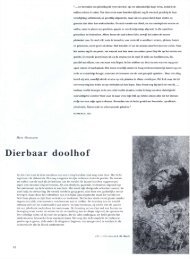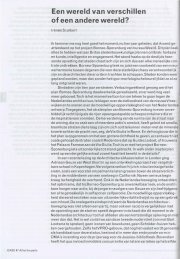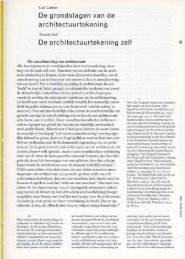Download PDF, 11 pagina's, 4,77 MB - OASE Journal for Architecture
Download PDF, 11 pagina's, 4,77 MB - OASE Journal for Architecture
Download PDF, 11 pagina's, 4,77 MB - OASE Journal for Architecture
Create successful ePaper yourself
Turn your PDF publications into a flip-book with our unique Google optimized e-Paper software.
Leberecht Migge<br />
Tuintechniek en tuinkunst<br />
Gardening and Garden art<br />
What is garden art, pure or applied art?<br />
The free use of gardening material has little or noth<br />
ing to do with freedom of mind. On the contrary:<br />
the deployment of plants in the garden is generally<br />
bound to a purpose, if only the purpose of making<br />
seeds or cuttings grow, with the help of soil, water<br />
and air, into plants and blooming flowers. Garden<br />
art is there<strong>for</strong>e, like architecture, applied art.<br />
But then, one might ask, what is the difference<br />
between architecture and garden art, apart from the<br />
materials? This question is an important, if not vital<br />
one <strong>for</strong> garden art as art. Much, indeed most of what<br />
we conventionally call garden art today is nothing<br />
but green utility art, green spatial art, green<br />
architecture. The know-how required is important<br />
and irreplaceable. Still, it is a value that relates to<br />
craft, to aesthetics even, not to art proper.<br />
The true value of garden art cannot there<strong>for</strong>e be<br />
found in the building aspect, it must be found in the<br />
plant. The essence of the plant must also constitute<br />
the essence of garden art as an independent art<br />
And that alone ...<br />
I say: all, and even the greenest sculpting in the<br />
garden belongs to architecture. We need not concern<br />
ourselves with the beauty of the garden. It is not<br />
invented, it grows: garden art arises solely from<br />
garden growth.<br />
"Where is garden art, in the utility or the pleasure<br />
garden?<br />
[ ... ]<br />
The existence and life of all plants are at the same<br />
time both useful and beautiful: there are no<br />
'un-beautiful' plants.<br />
Consequently, there is no such thing as a utility<br />
garden as rhythmically opposed to an 'ornamental<br />
garden'. Such a distinction can only be made <strong>for</strong><br />
functional purposes and even then hardly ever<br />
justified. No-one will call even the most rationally<br />
planned vegetable garden 'ugly'; rather, they may call<br />
it 'prosaic' or, more precisely, 'practical' - and<br />
consequently beautiful.<br />
The distinction between the kitchen garden and<br />
the pleasure garden based on the difference in actual<br />
contents is purely subjective and time-related; it has<br />
79<br />
Wat is tuinkunst: vrije of toegepaste kunst?<br />
De vrijheid van het tuinmateriaal heeft weinig of niets<br />
uit te staan met geestelijke vrijheid. lntegendeel: het<br />
gebruik van planten in een tuin heeft meestal een<br />
bepaald doel, al was het maar om uit zaad of een stekje<br />
met behulp van aarde, water en Iucht planten te Iaten<br />
groeien en bloemen te Iaten bloeien: de tuinkunst is<br />
dus, net als de bouwkunst, een toegepaste kunst.<br />
Maar wat, zal men vragen, is dan het onderscheid<br />
tussen bouwkunst en tuinkunst, voorzover dit niet in<br />
het materiaal besloten ligt? Dit is een vraag, zo niet de<br />
kernvraag naar de tuinkunst als kunst. Vee I, het meeste<br />
zelfs, van wat we tegenwoordig als tuinkunst aanmer<br />
ken is niets anders dan groene functionele kunst, groe<br />
ne ruimtelijke kunst, groene bouwkunst. De hiervoor<br />
vereiste kennis van zaken is belangrijk en onvervang<br />
baar, zij vormt echter slechts een ambachtelijke, op zijn<br />
best esthetische, maar geen specifiek artistieke<br />
waarde.<br />
De intrinsieke waarde van tuinkunst ligt dus niet in<br />
de bouw, maar moet in de planten gezocht worden. In<br />
het wezen van de planten, en aileen daarin, ligt het<br />
wezen van de tuinkunst als zelfstandige kunst.<br />
Naar mijn mening valt aile vormgeving in de tuin,<br />
ook de groenste, onder de bouwkunst. Om de schoon<br />
heid van de tuin hoeven wij ons niet te bekommeren.<br />
Die wordt niet bedacht, zij groeit: tuinkunst ontstaat<br />
aileen uit de groei van de tuin.<br />
Waar is er sprake van tuinkunst, in de nutstuin of<br />
in de pleziertuin?<br />
[ ... ]<br />
Aile planten zijn en Ieven zowel doelmatig als mooi:<br />
er zijn geen 'on-mooie' planten.<br />
Daaruit volgt dat er ook geen ritmische tegenstel<br />
ling bestaat tussen nutstuinen en 'siertuinen'. Dat is<br />
een !outer functionele indeling en ook als zodanig<br />
meestal ongefundeerd. Niemand zal zelfs de meest<br />
rationele groentetuin direct 'lelijk' vinden; hij zal hem<br />
misschien 'sober', of beter gezegd 'zakelijk' noemen:<br />
daarmee noemt hij hem mooi.<br />
Het onderscheid tussen nuts- en pleziertuinen naar<br />
feitelijke inhoud is puur subjectief en tijdgebonden;<br />
met kunst of economie als zodanig heeft het niets te<br />
maken; het is het resultaat van de wisselende sociale<br />
•<br />
•<br />
•<br />
•<br />
•<br />
•<br />
•<br />
-<br />
-<br />
•<br />
•
0<br />
..c<br />
c<br />
a.><br />
c<br />
c<br />
0<br />
CJ)<br />
a.><br />
"'0<br />
c<br />
co<br />
><br />
"'0<br />
c<br />
0<br />
0<br />
2<br />
-ro<br />
0:<br />
.. :<br />
. .<br />
..<br />
•I<br />
"'I-AMI.- ! : c.:"TLit<br />
:·<br />
,.<br />
,.<br />
DER<br />
/ONNE..N-HOE<br />
-4 \J1RT ICHAFT I HOF MIT N...EJCHf_<br />
I \./lRKFT.l.TTE.H UttO C..LRATL<br />
!>HAUPT- UNO NE.&LNE.INC.lHC.l<br />
.. E..ROC.ARTLH /OUNC./ILO<br />
!5 HANDEl/ KULTUR<br />
6C.LA/C.ARTE.N<br />
7 Z.\./E.RC..O&IT-C.ARTE.H<br />
/.:>MME.Rl\WMlN-
nothing to do with art or economy as such; it stems<br />
from the changeable social or aesthetic outlook of<br />
the people working the garden at some point in<br />
time.<br />
Space and soil - constructive and<br />
functional vegetation<br />
So if it is not the actual content that determines the<br />
garden, then what is it? It is our perception of space<br />
that gives birth to a garden, and it is the human eye<br />
that conveys this spatial arrangement. And since this<br />
organ is bound to a human scale, it is essentially<br />
one's point of view which conitions the garden.<br />
Looking down on a space (biro's eye view), our per<br />
spective differs from when we are in it. From above,<br />
it is my object; in it, I am its subject. If it seems clear<br />
that the vegetation is, after all, the carrier of any real<br />
perception of the garden, then one can ef<strong>for</strong>tlessly<br />
divide the garden vegetation into two groups -<br />
constructive and functional. The <strong>for</strong>mer defines the<br />
space (das Kleid- the garb/decor), the latter the<br />
ground (den Inhalt - the content) of the garden. The<br />
garden itself, however, does not emerge as such until<br />
all the vegetation, both articulative and infilling, has<br />
risen out of the surrounding vegetation with a<br />
certain degree of lushness, rarity and singularity.<br />
This elevated vegetation (that follows the ideal of a<br />
southern vegetation) is, after all, the hallmark of a<br />
genuine garden.<br />
(Excerpt from: 'Gartentechnik und Gartenkunst' ,<br />
in: Gartenschiinheit, 6 [1925], No.4)<br />
The use of vegetation in the garden<br />
It is true that we have imported new plants and bred<br />
new varieties in such numbers and dive [ sity that<br />
would have been unthinkable in the old garden<br />
cultures. But a greater wealth of resources does not<br />
of itself add to the richness of the design, and more<br />
often than not only detracts from it. The increased<br />
choice of materials hampers the choice of the<br />
spiritually dominant element and fosters amateurism.<br />
However, amateurism (Liebhaberei) is cheap and<br />
practically the opposite of love, which is unique and<br />
exclusive. Modern gardens generally lack the<br />
simplicity that is the basis of all creative expression,<br />
if not creation itself...<br />
Collectors' or amateurs' gardens are gardens that<br />
used to be, or rather: gardens that might have been,<br />
the 'grand old men of fine garden art'. We find them<br />
in hundreds of <strong>for</strong>ms as dendrological, botanical or<br />
floral species gardens, in all those places where the<br />
collector's or breeder's mania has overrun common<br />
gardening sense. The most blatant perpetrators take<br />
the <strong>for</strong>m of all-loving plant collectors, and that, to<br />
some extent, is a trap into which almost every gar<br />
dening novice tends to fall. And although, as special<br />
ty gardens, such pseudo-gardens at least require, or<br />
else yield, a heightened level of technical skill, they<br />
remain untechnical in a spiritual sense. For any type<br />
of technique, and especially the nature-born garden-<br />
81<br />
of esthetische grondhouding van de tuin-mensen van<br />
het moment.<br />
Ruimte en bodem- constructieve en<br />
functionele vegetatie<br />
Als het dan niet de inhoud is die de tuin bepaalt, wat is<br />
het dan wei? Een tuin ontstaat vanuit onze perceptie<br />
van de ruimte, en het menselijk oog brengt deze ruim<br />
telijke indeling tot stand. En aangezien dit orgaan aan<br />
menselijke maatstaven is gebonden, is het in wezen<br />
het perspectief waardoor de tuin bepaald wordt. Als<br />
we een bepaalde ruimte van boven bekijken (in vogel<br />
vluchtperspectief), hanteren we andere maatstaven<br />
dan wanneer we erin zijn. Van boven bezien is de<br />
ruimte mijn object, erin ben ik het subject ervan. En als<br />
uiteindelijk schijnt vast te staan dat de vegetatie de<br />
drager is van elke voorstelling die we van een tuin<br />
kunnen hebben, dan kan men deze tuinvegetatie naar<br />
believen in twee groepen verdelen: de constructieve en<br />
de functionele. De eerste bepaalt de ruimte (de aan<br />
kleding) en de tweede de bodem (de inhoud) van de<br />
tuin. De tuin zelf verschijnt echter pas werkelijk als<br />
tuin als aile vegetatie, zowel de geledende als de<br />
vullende, met een bepaalde weelderigheid, een zekere<br />
zeldzaamheid en eigenheid uitrijst boven de omringen<br />
de vegetatie. Deze boven de rest uitstekende vegetatie<br />
(die het ideaalbeeld van een zuidelijke vegetatie<br />
nastreeft) is zelfs het kenmerk van de ware tuin.<br />
(Uit: 'Gartentechnik und Gartenkunst', in:<br />
Gartenschonheit, 6 [1925], nr. 4)<br />
Over het gebruik van vegetatie in tuinen<br />
Het is een feit dat we nieuwe planten ge'fmporteerd en<br />
nieuwe varieteiten gekweekt hebben in een hoeveel<br />
heid en verscheidenheid zeals die in de vroegere<br />
tuinculturen in de verste verte niet voorhanden was.<br />
Maar een rijkere keuze aan materialen zegt nog niets<br />
over rijkdom in vormgeving, eerder het tegendeel. De<br />
grotere keuze in materialen maakt de keuze van het<br />
spiritueel dominante element juist moeilijker en noodt<br />
tot liefhebberij. Liefhebberij is echter goedkoop en bij<br />
na het tegendeel van liefde, die eenmalig en exclusief<br />
is. De hedendaagse tuinen missen doorgaans de een<br />
voud die de grondslag is voor aile scheppingskracht,<br />
zo niet de schepping zelf...<br />
Gewezen tuinen, of liever: tuinen die er geweest<br />
hadden kunnen zijn, zogezegd de 'oude heren van de<br />
schone tuinkunst', zo kun je de verzamel- of liefheb<br />
berijtuinen noemen. Bij honderden komen we ze tegen,<br />
gespecialiseerde botanische, bomen- of bloementui<br />
nen, overal waar de verzamel- of kweekzucht het<br />
gezonde tuinverstand heeft overwoekerd. Het meest<br />
opdringerig manifesteren de liefhebbers zich als<br />
plantenverzamelaars die alles mooi vinden; een gevaar<br />
dat tot op zekere hoogte iedere beginnende tuinier<br />
bedreigt. En al vereisen dit soort pseudo-tuinen als<br />
gespecialiseerde tuinen tenminste een verhoogd tech<br />
nisch vermogen, of hebben dit tot gevolg, spiritueel<br />
gezien blijven ze a-technisch. Een techniek, en met<br />
name de aan de natuur ontsproten techniek van het<br />
-<br />
-<br />
-<br />
-<br />
•
ing technique, can only be healthy if, instead of<br />
exhausting itself in details, it draws its imaginative<br />
power from the grand <strong>for</strong>m ...<br />
(Excerpt from: 'Die Gartenmoderne -<br />
Ein Plagiat?', in: Gartenschijnheit, 6 [1925], No. 9)<br />
The garden of the future<br />
We now come to the heart of our query into the<br />
garden of the future: should gardens be beautiful?<br />
Based on thousands of years of gardening history,<br />
aided by a gardening life rich in experience, and the<br />
willpower to secure a future <strong>for</strong> a youthful era, our<br />
answer must be: No! All that is required of gardens<br />
is that they should exist, and nothing else.<br />
'Beautiful' gardens cannot be identified objective<br />
ly. The history of gardening has successively regis<br />
tered and approved green elegies and rigid terrace<br />
constructions, courtyards poor in plants and entire<br />
cities made out of screens of greenery, kitchen gar<br />
dens that were the pinnacle of rationality and the<br />
subtlest of orl).amental gardens solely devoted to<br />
beauty. And the more recent 'garden art' is practical<br />
ly bursting with <strong>for</strong>mal contradictions, alternating<br />
between sentimental landscape images and purely<br />
decorative gardens within the shortest of time spans.<br />
Nowadays, moreover, the high and mighty realm of<br />
garden art allows everything and nothing alike. Peo<br />
ple make do with modest floral cultivation and all<br />
the more immodest planting of public utilities such<br />
as cemeteries and playgrounds, in an ef<strong>for</strong>t to cope<br />
82<br />
tuinieren, is namelijk aileen dan levensvatbaar wanneer<br />
zij zich niet in details verliest, maar haar creatieve<br />
kracht put uit de grote vorm ...<br />
(Uit: 'Die Gartenmoderne- ein Plagiat?', in:<br />
Gartensch6nheit, 6 [1925], nr. 9)<br />
De tuin van de toekomst<br />
We komen tot de kern van onze vraag naar de tuin van<br />
de toekomst: moeten tuinen mooi zijn? Op basis van<br />
vele duizenden jaren tuingeschiedenis, ons gesteund<br />
wetend door een tuinleven rijk aan ervaringen, en<br />
krachtens de wil om een jeugdig tijdperk een eigen<br />
toekomst te geven, antwoorden wij: Nee! Allereerst<br />
horen tuinen er te zijn en niets meer dan dat.<br />
Of een tuin mooi is valt objectief niet te bewijzen.<br />
De tuingeschiedenis heeft achtereenvolgens groene<br />
elegieen en starre terrasconstructies, plant-arme<br />
binnenplaatsen en hele steden opgebouwd uit groene<br />
coulissen, de meest rationele nutstuinen en de meest<br />
geraffineerde siertuinen als ideaal gekend en ernaar<br />
beoordeeld. En de 'tuinkunst' van de nieuwe tijd staat<br />
gewoon bol van de <strong>for</strong>mele tegenstellingen, die binnen<br />
de kortste tijdspannes uiteenlopen van sentimentele<br />
landschapsbeelden tot pure tuindecoratie. Tegenwoor<br />
cftg is bovendien in het verheven rijk van de tuinkunst<br />
alles en niets geoorloofd. Men slaat zich zo goed en zo<br />
kwaad als het gaat, met een bescheiden verering van<br />
bloemen en des te onbescheidener beplanting van<br />
openbare voorzieningen als begraafplaatsen en speel<br />
plaatsen, door de geestel ijke leegte en het gebrek a an
with the spiritual emptiness and lack of originality.<br />
Today, one hundred garden owners will have one<br />
hundred views on garden beauty. They should have<br />
none at all, or just this one: gardens need not be<br />
made beautiful, they will become beautiful on their<br />
own. They will simply grow to be beautiful.<br />
This is what they would do in reality as well, if<br />
we gave them time, and had it not been <strong>for</strong> the<br />
prominence of a 'learned art of gardening', the<br />
proprietors of which have thrown all their weight<br />
into creating the illusion in the public eye that the<br />
creation and maintenance of an artistic garden<br />
requires all the mysterious powert and skills that<br />
they possess. Modern garden art has never produced<br />
any beautiful gardens- except those which it itself<br />
finds beautiful- and certainly not stylistically beauti<br />
ful in the sense, <strong>for</strong> instance, of a well-balanced clas<br />
sical garden. What this so-called garden architecture<br />
has done, with its material abundance and spiritual<br />
absurdity, is prevent a great many real gardens from<br />
coming into existence. After all, gardens as such, like<br />
most things meant <strong>for</strong> everyday use, require nothing<br />
but the craft and engineering skills of suitably<br />
trained people, once the garden's space and contents<br />
have been determined by the impersonal factor of<br />
time. That does not include the playful experiments<br />
that are the exclusive domain of self-effacing<br />
dexterity.<br />
There is much evidence to support this view:<br />
why, <strong>for</strong> instance, have we not yet been successful in<br />
83<br />
originaliteit heen. Honderd tuinbezitters hebben tegen<br />
woordig even zo vele meningen over wat een mooie<br />
tuin is. Ze zouden er helemaal geen moeten hebben, of<br />
slechts die ene: tuinen hoeven niet mooi gemaakt te<br />
worden, ze worden vanzelf mooi. Ze groeien gewoon<br />
mooi.<br />
Dat zouden ze ook werkelijk doen als we ze de tijd<br />
lieten en als er geen 'geleerde tuinkunst' bestond die<br />
met het gewicht van haar zaakwaarnemers steeds weer<br />
naar de buitenwereld toe suggereerde dat de artistieke<br />
tuin allerlei geheimzinnige krachten en vaardigheden<br />
vereist. Weliswaar heeft de moderne tuinarchitectuur<br />
nog nooit mooie tuinen voortgebracht- uitgezonderd<br />
degene die ze zelf mooi vindt -, althans niet mooi van<br />
stijl in de zin van bijvoorbeeld een afgewogen klassie<br />
ke tuin, maar door wat ze aan materiaal gekost heeft<br />
en door haar intellectuele absurditeit heeft deze zoge<br />
naamde tuinarchitectuur wei veel werkelijke tuinen ver<br />
hinderd. Want zoals de meeste dingen die wij dagelijks<br />
gebruiken hebben tuinen, zodra ruimte en inhoud door<br />
de onpersoonlijke factor tijd zijn vastgelegd, in wezen<br />
slechts de ambachtelijke en technische verzorging<br />
nodig van adequaat geschoolde personen. Speelse<br />
experimenten zijn hier buiten beschouwing gelaten;<br />
deze zijn voorbehouden aan offervaardige dappere<br />
geesten.<br />
Voor deze opvatting zijn vele bewijzen aan te voe<br />
ren: waarom lukt het bijvoorbeeld nog steeds niet om<br />
de mooie kleine tuin vorm te geven die miljoenvoudig<br />
het tuinbeeld van onze steden domineert? Juist omdat<br />
-<br />
-<br />
-<br />
-<br />
-<br />
•<br />
•<br />
-<br />
-<br />
•<br />
•
ii Zwembad omringd door pruimenbomen, met clematisslingers. Tekening door Rosa Migge-Lenzner f<br />
Swimming pool surrounded by plum trees with garlands of clematis. Drawing by Rosa Migge-Lenzner<br />
i Daktuin. Tekening door Rosa Migge-Lenzner/ Roof garden. Drawing by Rosa Migge-Lenzner<br />
84
making beautiful gardens out of the millions of small<br />
gardens that dominate our cities? Simply <strong>for</strong> the<br />
reason that economic, social, and technical<br />
conditions will not yield to aesthetic ideas. What is<br />
essential is what a garden economy like ours can<br />
af<strong>for</strong>d itself in terms of arbours, borders, trees and<br />
shrubs; how one garden relates to the next and to all<br />
other gardens; how this category of grenery pres<br />
ents itself to the competition and to the public eye.<br />
And the same holds true <strong>for</strong> almost all other garden<br />
types that we sketched earlier.<br />
If, there<strong>for</strong>e, we are to speak of the vocation of<br />
garden designers in our time, thei tasks are limited<br />
to preparing, arranging, and paving the way.<br />
What we need from real garden architecture is that<br />
it should clear the way <strong>for</strong> many gardens, <strong>for</strong> every<br />
man's garden. Yet this kind of garden architecture<br />
requires knowledge of the economic, social, and<br />
technical conditions in which these gardens<br />
originate, rather than aesthetic skills and tricks of<br />
the trade. In today's society, garden design basically<br />
means creating gardens. It is our task to let gardens<br />
grow. And whoever considers this free growth<br />
concept to be somewhat crude and undisciplined is<br />
right. But then again, even the famous gardens of<br />
the Palace of Versailles cannot have been altogether<br />
lovely when they were first planted. This rough<br />
sobriety conceals the gem of functionality, and the<br />
experts see more spirit and rhythm, and certainly<br />
more life today than in the exhausted bourgeois<br />
gardening traditions of the past. The garden style of<br />
our time? We need not concern ourselves with it. It<br />
will present itself when the time is right, of its own<br />
accord. It will spring, in the same way other garden<br />
styles have done in the past, from the life o its own<br />
epoch. Where once the evolution of gardens and<br />
garden styles was based mainly on social-aesthetic<br />
foundations, economic-ethical demands have taken<br />
over. Whereas the design of gardens used to be<br />
based on floricultural and sculptural principles, con<br />
structive and technical principles predominate today.<br />
Whereas in the past only the upper classes could<br />
af<strong>for</strong>d to have a garden, today increasingly the<br />
middle and lower classes in society are the ones who<br />
hanker <strong>for</strong> the soil, hence <strong>for</strong> a garden. Mass is what<br />
will determine the outlook and style of our gardens.<br />
Mass and uni<strong>for</strong>mity will yield the type, and the type<br />
will yield the standard, which is not generally subject<br />
to alterations on the grounds of taste until after it<br />
has reached its peak. In other words, it is not<br />
important whether gardens are beautiful, but that<br />
they exist. Gardens <strong>for</strong> everyone! But what kind of<br />
garden?<br />
The garden of the future will be remarkable <strong>for</strong><br />
various reasons. It will be a utility garden, it will be a<br />
working garden, and it will be a glass garden. Three<br />
aspects that, however dissimilar at first sight, are<br />
nevertheless interrelated, referring to the three issues<br />
of garden economy, garden maintenance, and garden<br />
play that are firmly rooted in history.<br />
85<br />
economische, sociale en technische omstandigheden<br />
zich niets aantrekken van esthetische voorstellingen:<br />
wat zo'n tuineconomie als prieel, als border, als boom<br />
en struik wenst en kan opbrengen, hoe het individuele<br />
tuinbeeld zich tot dat van de buren, tot de groep, tot de<br />
kolonie verhoudt, hoe dit groenmodel zich verhoudt tot<br />
zijn concurrent en daarmee tot de gemeenschap- daar<br />
gaat het om. Daar gaat het oak om bij bijna aile andere<br />
tuintypen die we in het vorige artikel kart geschetst<br />
hebben.<br />
Als men zich dus afvraagt wat het beroep van<br />
tuinontwerper in deze tijd inhoudt, dan kunnen zij tach<br />
aileen opgevat worden als voorbereiders, wegbereiders<br />
en planners. De weg vrijmaken voor vele tuinen, voor<br />
de tuin van eenieder, dat is de ware tuinarchitectuur<br />
die we nodig hebben. Die vereist echter niet zozeer<br />
esthetische vaardigheden en aangeleerde <strong>for</strong>mules als<br />
wei kennis van de economische, sociale en technische<br />
omstandigheden waarin tuinen ontstaan. Tuinen<br />
vormgeven houdt tegenwoordig in wezen in: tuinen<br />
scheppen. Tuinen Iaten groeien is onze taak. En wie dit<br />
groeien nag wat rauw en ongedisciplineerd voorkomt<br />
heeft gelijk; maar de beroemde koninklijke tuinen van<br />
Versai lies hebben er op de dag van hun geboorte vast<br />
oak niet zo lieflijk uitgezien. Nee, deze lampe zakelijk<br />
heid verbergt een edelsteen: functionaliteit, waarin de<br />
vakman van tegenwoordig meer geest en ritme ziet, in<br />
elk geval meer Ieven, dan in heel het vermoeide bour<br />
geois-tuinbedrijf van voorbije tijden. Over de tuinstijl<br />
van onze tijd hoeven we ons geen zorgen te maken.<br />
Die komt wei als het zover is, zonder dat wij er iets voor<br />
hoeven doen. Die zal worden zoals andere tuinstijlen<br />
oak zijn geworden: groeiend vanuit het Ieven van zijn<br />
tijd. Was het destijds meer een maatschappelijk<br />
esthetische basis waarop tuinen en tuinstijlen zich<br />
ontwikkelden, tegenwoordig moeten tuinen vooral vol<br />
doen aan economisch-ethische eisen. Werden tuinen<br />
destijds voornamelijk bepaald door plastisch-floristi<br />
sche regels, tegenwoordig zijn deze meer constructief<br />
technisch van aard. Waren het eertijds de bevoorrechte<br />
klassen die zich een tuin konden veroorloven, tegen<br />
woordig is het de brede onderlaag van de bevolking die<br />
een hang heeft naar de grand en daarmee naar de tuin.<br />
Massaliteit is wat ons tuinbeeld, onze tuinstijl zal<br />
bepalen. Uit de massa en de eenvormigheid groeit het<br />
type, en uit het type de wetmatige vorm, die gewoonlijk<br />
pas smaakvariaties gaat vertonen is als zij over haar<br />
hoogtepunt heen is. Het is dus niet belangrijk dat<br />
tuinen mooi zijn, maar wei dat er tuinen zijn. Een tuin<br />
voor iedereen! Maar welke tuin?<br />
De tuin van de toekomst zal in meerdere opzichten<br />
opmerkelijk zijn. Het zal een nutstuin zijn, een werk<br />
tuin, en: een glastuin. Drie kenmerken die, hoezeer ze<br />
oak ogenschijnlijk van elkaar verschillen, tach met<br />
elkaar verweven zijn. Drie vragen naar tuinaanleg, naar<br />
tuinieren en naar de tuin als speelterrein, alledrie diep<br />
geworteld in het historische tijdperk.<br />
Aan het nutsaspect van de tuin hoeven we na dit<br />
a lies niet vee I woorden meer te besteden. Om de<br />
nuttige planten in dit verband te verzekeren van een<br />
I<br />
I<br />
I<br />
I<br />
•<br />
I<br />
I<br />
•<br />
•<br />
I<br />
I
The utility of the garden need not be discussed<br />
much further. It should be enough to invoke the<br />
fundamentally functional origins of the garden<br />
throughout world history to secure useful plants a<br />
place of honour in the garden of the future. But it is<br />
not just the body but also the mind that is nourished<br />
by the fruit, which has not accidentally served as a<br />
legendary device since the Garden of Eden. Since<br />
then, the satisfaction of one's physical needs has<br />
always been sacrosanct, or at least should have been.<br />
And in the same way that the satisfaction of these<br />
needs, when taken to the point of excess, has always<br />
degenerated into extravagance, the seed of degenera<br />
tion was sown in the garden the moment it began to<br />
distance itself from its natural origin: simple fertility.<br />
Whoever or whatever was it, in ancient Egypt, in the<br />
Orient or during the Middle Ages, who caused this<br />
unhappy divorce between the vegetable garden and<br />
the ornamental garden, or even the complete<br />
elimination of the <strong>for</strong>mer? It is not very likely that<br />
this separation was made to enhance the beauty of<br />
the garden, and it has certainly damaged the life<br />
of the garden.<br />
We, the people of today, have no cause what<br />
soever to disregard or degrade what is useful in our<br />
gardens. We should not doubt the utility of the<br />
garden and its fruits any more than we do the utility<br />
of cemeteries or the uses of the garden <strong>for</strong> pleasure<br />
or play. Indeed, in an era of economic decline, we as<br />
Europeans have every reason to devote much greater<br />
86<br />
ereplaats volstaat het te verwijzen naar de rationele<br />
oorsprong van de tuin overal ter wereld. Maar niet<br />
aileen het I ichaam, ook de geest eet van de vrucht, die<br />
niet voor niets al in het paradijs een legendarische rol<br />
speelde. Bovendien is de bevrediging van de lichame<br />
lijke behoeften op aarde altijd iets heiligs geweest,<br />
of had dat in ieder geval moeten zijn. En zoals deze<br />
behoefte, lichtvaardig overschreden, telkens weer<br />
ontaardde in destructieve luxe, zo droeg ook de tuin de<br />
kiem van de degeneratie in zich vanaf het moment dat<br />
hij zich ging verwijderen van zijn natuurlijke oorsprong:<br />
simpele vruchtbaarheid. Wie of wat heeft toch in het<br />
oude Egypte, in de Orient of in de Middeleeuwen die<br />
noodlottige scheiding aangebracht tussen de nutstuin<br />
en de siertuin of zelfs de eerste compleet afgeschaft!<br />
Het valt niet aan te nemen dat de schoonheid van<br />
tuinen gediend was met deze scheiding, en voor het<br />
Ieven in de tuin zelf was zij zeker schadelijk.<br />
Vandaag de dag hebben wij niet de minste reden het<br />
nuttige in een tuin te negeren of te geringschatten.<br />
Zoals wij het nut van een kerkhof als vanzelf inzien,<br />
zoals we de tuin vanzelfsprekend gebruiken voor spel<br />
en wonen, zo moeten we ook het belang van de vrucht<br />
van de tuin onderkennen. Er is voor ons, economisch<br />
verzwakte Europeanen, zelfs aile reden om meer en<br />
bl ijvende aandacht te schenken a an de opbrengst van<br />
de kleine stukjes grond, onze miljoenen tuinen, zoals ik<br />
reeds in mijn boek Deutsche Binnenko/onisation naar<br />
voren bracht. De tuin van de toekomst mag zijn karak<br />
ter best in essentie aan de utiliteitsgedachte ontlenen.
and lasting attention to the possible yields from<br />
these little plots, our millions of gardens, as I have<br />
expounded in my book Deutsche Binnenkolonisation.<br />
In shaping the garden of the future, we would in fact<br />
do well to take the idea of utility as our guideline.<br />
But we will not be satisfied with what the garden<br />
produces of its own accord, we will see to it<br />
ourselves. We will want, and need, to l>rk our<br />
garden ourselves. We will need to because the many<br />
hundreds of thousands of garden owners - whose<br />
numbers are soaring - cannot af<strong>for</strong>d to have their<br />
gardens maintained by others. And we will want to<br />
because of that reconciliatory la of nature which<br />
<strong>for</strong>ces us to love our duty. And some higher provi<br />
dence must have ordained that all books of wisdom<br />
should begin with declaring labour to be both the<br />
duty and the salvation of mankind. And if there is a<br />
kind of labour that reconciles man with his fate and<br />
suffering, then it is our daily work in the garden that<br />
mirrors the cycle of nature.<br />
Who on earth was responsible <strong>for</strong> spreading the<br />
infamy that gardens are there <strong>for</strong> us to pass the time<br />
in idleness and that we need leisure, nothing but<br />
leisure, to enjoy them to their fullest! Leisure is an<br />
empty word. Nature in all its greatness will only<br />
open itself, in our little gardens, to those who act,<br />
who think, who try to unravel its secrets both with<br />
their heads and their hands. Genuine work makes<br />
<strong>for</strong> genuine leisure and vice versa. Variety of work is<br />
what counts, inside and out. The garden labour<br />
per<strong>for</strong>med by the hundreds of thousands of garden<br />
owners is also important because of its rhythm, its<br />
dynamics. Dynamism yields variety. Variety yields<br />
choice; choice sharpens <strong>for</strong>m. The sportsman, giving<br />
his best per<strong>for</strong>mance and using the best euipment,<br />
will turn his garden into a sporting garden, the<br />
allotment gardener familiar with natural life will<br />
create his own green kingdom, technically proficient<br />
commercial gardeners reach an ever expanding mar<br />
ket selling high quality produce, amateurs will raise<br />
the overall level of gardening conducting imaginative<br />
experiments, and even the choosy walker will put<br />
new energy and direction in his public promenade.<br />
This is to demonstrate how we are all unconsciously<br />
involved in defining the garden style of our time: in<br />
our own working gardens.<br />
This working garden must unquestionably be a<br />
highly technological garden, since only quality work<br />
is profitable and interesting in the long run. Hence,<br />
whatever our attitude toward the technical problems<br />
of ·our time, the technical knowledge is available and<br />
it is not within our power to shield off parts (includ<br />
ing the vital parts) of our daily lives from it. After all,<br />
technology is nothing other than the actualisation of<br />
our intellectual abilities, even our spiritual tenden<br />
cies. The mere fact that we have gardens is sufficient<br />
proof in itself. The fact that the fruits and flowers<br />
produced by our gardens are so much more refined<br />
than the products of the field is a mere reflection of<br />
our desire <strong>for</strong> refinement, <strong>for</strong> spiritualisation.<br />
87<br />
Maar we zullen geen genoegen nemen met de<br />
opbrengst van de tuin, we zullen deze opbrengst zelf tot<br />
stand willen brengen. We zullen in onze tuin willen en<br />
moeten werken. Moeten, omdat vele honderdduizenden<br />
-en dit aantal neemt stormenderhand toe- het zich<br />
niet kunnen permitteren hun tuin door anderen te Iaten<br />
verzorgen. Willen, omdat een verzoenende natuurwet<br />
ons gebiedt deze plicht lief te hebben. Niet zonder een<br />
hogere bedoeling stellen de wijze boeken al van meet<br />
af aan waarin de plicht, maar ook het heil van de<br />
mensheid I igt: arbeid. En als er arbeid bestaat die de<br />
mens met zijn lot en zijn leed kan verzoenen, dan is het<br />
het werken in de tuin waarin zich dagelijks de omloop<br />
van de aarde weerspiegelt.<br />
Wie heeft toch in vredesnaam de schandelijke<br />
bewering in de wereld gebracht dat de tuin er is om in<br />
te luieren en dat men om er waarlijk van te kunnen<br />
genieten vrije tijd moet hebben, aileen maar vrije tijd.<br />
Vrije tijd is een ledig begrip. Aileen wie actief is, wie<br />
denkt, met hoofd en hand naspeuringen doet, krijgt in<br />
zijn kleine tuin toegang tot de grote natuur. Ware<br />
arbeid houdt tevens echte vrije tijd in en omgekeerd.<br />
Afwisseling in het werk is waar het om gaat, zowel<br />
innerlijk als uiterlijk. Het tuinieren van de honderd<br />
duizend is ook ritmisch niet onbelangrijk: het beweegt.<br />
Beweging schept afwissel in g. Varianten zorgen voor<br />
selectie; selectie scherpt de vormen. Zo vormt de spor<br />
ter via de beste prestaties en de beste voorzieningen<br />
zijn sporttuin, zo ontwikkelt de volkstuinder, met het<br />
natuurleven vertrouwd, zijn greene rijk, zo verspreidt de<br />
beroepstuinder via technische topprestaties zijn pro<br />
ducten steeds verder, zo verhoogt de I iefhebber via zijn<br />
onversaagde experimenten het algemene tuinniveau, zo<br />
geeft zelfs nog de kritische wandelaar vaart en richting<br />
aan zijn ommetje. Zo werkt eenieder onbewust aan de<br />
tuinstijl van zijn tijd: in zijn werktuin.<br />
Het lijdt geen twijfel dat deze werktuin een tuin op<br />
technisch hoog niveau moet zijn. Aileen kwalitatief<br />
hoogstaande arbeid rendeert en is op den duur interes<br />
sant. Hoe we dus ook staan tegenover de problemen<br />
van de techniek in onze tijd: we hebben deze techniek<br />
en het ligt niet in onze macht om een bepaald deel van<br />
ons reele bestaan, en nog wei het belangrijkste, daar<br />
van uit te sluiten. Welbeschouwd is onze techniek niets<br />
anders dan de concrete vertaling van onze geestelijke<br />
vermogens, onze zielsneigingen zelfs. Aileen al het<br />
bestaan van de tuin bewijst dat dat zo is. Want de in<br />
vergelijking met veldgewassen meer verfijnde vruchten<br />
en bloemen die men er vindt zijn simpelweg het gevolg<br />
van de wens tot verfijning, zeg maar de vergeestelijking<br />
van de mens. Bloemen en vruchten zijn nu eenmaal<br />
niets anders dan producten van de zonne-energie, in zo<br />
sterke mate zelfs dat de zonne-energie hun smaak,<br />
grootte en schoonheid bijna automatisch doet toene<br />
men. Hierdoor wordt de mens geestelijk, en uiteindelijk<br />
ook feitelijk, naar een zuidelijkere, idealere wereld<br />
getrokken. Als hij er zelf niet heen kan, kan hij hier in<br />
elk geval in de illusie ervan Ieven. Het middel dat hem<br />
daartoe ter beschikking staat is het temmen van de<br />
natuur door een steeds verder ontwikkelde techniek.<br />
•<br />
•<br />
I<br />
I<br />
•<br />
•<br />
I
Flowers and fruits are simply the products of solar<br />
energy, to such an extent that their taste, size and<br />
beauty are almost automatically enhanced by their<br />
exposure to it. Human beings are similarly drawn to<br />
the south spiritually and, eventually, also physically.<br />
If we cannot actually go there, then we will at least<br />
create the illusion of being there. This can be done<br />
by curbing the <strong>for</strong>ces of nature with the help of our<br />
ever expanding technical knowledge and skills.<br />
Thus, our knowledge allows us to conjure up all the<br />
southern elements we require - or at least create that<br />
illusion - including in particular the southern sun<br />
and the lightness of life that comes with it. This<br />
explains our well-nigh insatiable and sometimes<br />
even grotesque craving <strong>for</strong> rare and exceptional<br />
(and almost unexceptionally southern) plants in our<br />
gardens.<br />
This also explains the popularity of the glass gar<br />
den or conservatory. Beyond the physical com<strong>for</strong>t we<br />
feel when exposed to longer hours of more intense<br />
sunlight, the conservatory symbolises our spiritual<br />
need <strong>for</strong> light and warmth, <strong>for</strong> lavishness and<br />
strength - our desire <strong>for</strong> the subtropics. As some<br />
support to our theory, this particular impropriety of<br />
arranging gardens according to a social hierarchy has<br />
never taken root in the conservatory. Its inhabitants<br />
have always enjoyed equal standing, regardless of<br />
whether they bore flowers or fruits; pineapples and<br />
orchids are equally refined and desirable. And in this<br />
way the conservatory will increasingly become<br />
central to the garden of the future, whether in large<br />
public or private parks or in the smallest of gardens.<br />
Even if it be nothing more than a glazed <strong>for</strong>cing<br />
frame, the illusion of the south, the will to achieve a<br />
higher goal, a paradise on earth, is preserved.<br />
(From Gartenscho'nheit, March 1927)<br />
Translation from the German language:<br />
Bookmakers, Nijmegen<br />
88<br />
Deze tovert nu aile zuidelijke dingen naar hem toe, of<br />
spiegelt ze hem voor, met name de zuidelijke zon en de<br />
lichtheid van het Ieven daaronder. Vandaar de bijna<br />
onsti I bare hang- soms op het groteske af- naar zeld<br />
zame en eigenaardige (bijna altijd zuidelijke) planten<br />
in de tuin.<br />
Vandaar ook de glas- of wintertuin. Deze verzinne<br />
beeldt, meer nog dan het lichamelijk welbehagen dat<br />
verlengde en versterkte zonnekracht ons biedt, het<br />
innerlijk verlangen van de mens naar Iicht en warmte,<br />
naar weelderigheid en kracht: naar de subtropen. Dit<br />
ondersteunt in niet geringe mate onze theorie dat die<br />
oneigenlijke sociale hierarchie van de tuin in de<br />
glastuin nooit een kenmerk is geweest. De planten<br />
die deze tuin bevolkten stonden in even hoog aanzien,<br />
of ze nu bloemen of vruchten droegen; ananas en<br />
orchideeen zijn beide even verfijnd en worden evenzeer<br />
begeerd. Zo zal in de toekomst de glastuin steeds meer<br />
het middelpunt van de tuin worden, zowel van de grote<br />
openbare en prive-parken als van de kleinste volkstuin<br />
tjes. Ook al blijft het beperkt tot een broeibedje onder<br />
glas: de illusie van het zuiden, het verlangen naar het<br />
hogere, het paradijs op aarde is gered.<br />
(Uit: Gartenschonheit, maart 1927)<br />
Vertaling uit het Duits: Bookmakers, Nijmegen


